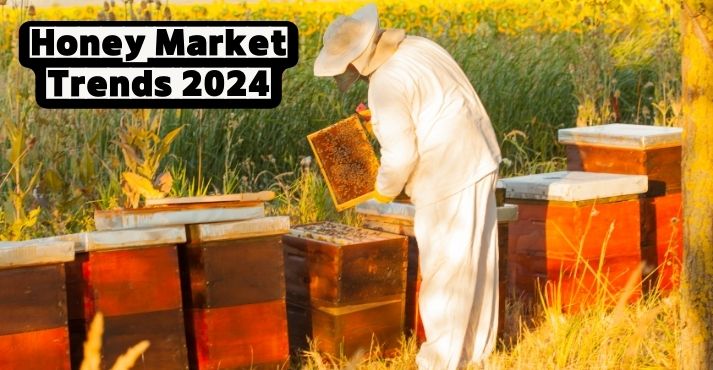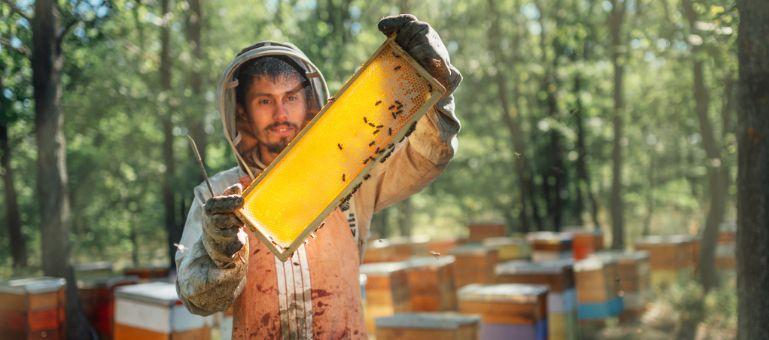In the vast landscape of the global honey market, understanding its dynamics through honey market analysis is essential.
Honey, a staple in various industries, holds economic significance worldwide. According to Statistica, the global revenue of the honey market amounts to US$50.01bn in 2024, illuminate the sheer scale of honey production and consumption, shedding light on the market’s intricate workings.
As we explore the world honey market, we will discover the facts and figures that define its current state.
Stay with us as we break down the complexities, providing a straightforward overview that unravels the layers of the honey market analysis, offering insights crucial for industry enthusiasts and decision-makers alike.
Key Trends in the Honey Market

Recognizing critical trends in the honey market is vital for consumers and industry stakeholders. Honey trends, reflective of evolving consumer preferences, guide the trajectory of this golden commodity.
Beyond its innate sweetness, essential minerals in honey add a nutritional dimension that resonates in the contemporary food landscape.
Before examining the specific honey trends, it’s essential to grasp honey’s dual role – as a delectable natural sweetener and a source of essential minerals in food and medicines. Let’s navigate through the unfolding trends shaping the future of honey consumption.
1. Consumption Patterns

Examining the present landscape of global honey consumption offers insights into pivotal trends steering the industry. This analysis reveals that honey is not merely a sweetener but a cultural staple with a significant presence in various cuisines worldwide.
Across continents, its role in traditional dishes and medicinal practices underlines its remarkable versatility. Notably, these consumption patterns extend beyond households to impact industrial honey production, exerting considerable influence on the world honey market.
Recent studies show how honey is becoming more critical in kitchens worldwide. It’s being used in many ways, not just as a sweetener. Whether in traditional recipes or on a larger scale, it’s making a significant impact, like in making honey industrially.
Current numbers reveal a 5.2% increase in global honey consumption in the past year, proving its growing importance in traditional and large-scale cooking. So, honey isn’t just tasty; it’s becoming a significant player in kitchens worldwide.
2. Production and Supply
In the vast stretch of the honey industry, certain regions emerge as pivotal players, shaping the global market with their distinctive contributions.
China, recognized as the world’s leading honey producer, boasts a production capacity that significantly influences the dynamics of the global honey industry.
Similarly, the United States, particularly in regions such as California and the Midwest, stands out as a critical contributor, offering a diverse array of honey varieties. With its rich beekeeping heritage and diverse ecosystems, Turkey adds another layer of significance to the global honey landscape.
Factors Influencing Production and Supply
Climate and Geography:
- Warm temperatures and abundant vegetation create optimal beekeeping conditions.
- Geographical diversity influences the types of honey produced.
Beekeeping Practices:
- Modern and sustainable approaches play a pivotal role in enhancing productivity.
- Fundamental to maintaining a robust honey industry.
Market Trends and Consumer Demand:
- Influential forces that shape the direction of the honey industry.
- Production decisions are driven by consumer preferences and evolving market trends.
Understanding these major producing regions and the factors influencing honey production provides valuable insights into the intricate dynamics of the global honey industry.
3. Trade Dynamics
International trade is a cornerstone of the honey market, intricately shaping its landscape and connecting producers with consumers globally.
The benefits of attending food and beverage exhibitions, where industry leaders engage in honey market analysis, become evident as we examine the trade dynamics.
Major Exporting Countries:
China:
- As the foremost honey producer, China is prominent in honey exports.
- The benefits of attending honey exhibitions are reflected in China’s ability to cater to diverse global demands.
Argentina:
- With a commitment to sustainable beekeeping practices, Argentina emerges as a significant exporter.
- Insights gained from honey market analysis contribute to producing high-quality honey sought after in international markets.
New Zealand:
- Renowned for its unique Manuka honey, New Zealand’s participation in honey exhibitions showcases its global impact.
- The international demand for New Zealand’s premium honey varieties exemplifies the benefits of attending such events.
Major Importing Countries:
United States:
- Despite being a significant honey producer, the U.S. relies on imports to meet diverse domestic preferences.
- Attending relevant meet-ups aids in aligning import trends with market demands.
Germany:
- As a significant honey importer, Germany’s attendance at honey exhibitions reflects its commitment to offering a wide array of honey varieties.
- Insights gathered contribute to catering to both traditional and specialty honey preferences.
Japan:
- With discerning consumers, Japan imports honey to fulfill diverse culinary and cultural demands.
- The benefits of attending honey exhibitions are evident in Japan’s ability to balance imports to meet various preferences.
Influenced by the insights gained at honey-related exhibitions and analysis, international trade plays a crucial role in the dynamic honey market.
Major exporting nations like China, Argentina, and New Zealand navigate global demands, while importers like the United States, Germany, and Japan strategically balance domestic and international honey preferences.
The interplay of trade dynamics and the benefits of attending industry exhibitions shape a resilient and responsive global honey market.
Top Honey Producing Countries

- China is the world’s leading honey producer, accounting for a significant share of global production.
- Turkey: Significant contributor with a rich history of beekeeping and diverse ecosystems.
- Iran: Significant honey producer with a rich history in apiculture.
- Ukraine: Noteworthy contributor to global honey production, adding to the industry’s diversity.
- Argentina: Noteworthy exporter with a commitment to sustainable beekeeping practices.
- India: Emerging as a key player, contributing significantly to the global honey market.
- Mexico: Significant honey producer with diverse landscapes supporting beekeeping activities.
- Russia: Considerable honey production, influenced by its vast geographical expanse.
- United States: Major honey producer, diverse varieties produced in regions like California and the Midwest.
- New Zealand: Renowned for unique Manuka honey, contributing to the premium honey market.
These countries collectively shape the global honey industry, meeting the diverse demands of consumers worldwide.
Market Drivers and Challenges
Regarding industrial honey production and distribution, the market is propelled forward by various drivers and encounters challenges that influence its trajectory. Understanding these dynamics is pivotal for stakeholders navigating the elaborate landscape of honey market analysis.
Market Drivers
The honey market is flourishing, driven by the demand for natural food options. With health-conscious trends rising, honey, recognized as a natural sweetener, has become an appealing alternative to refined sugars.
The market benefits from its perceived wholesome qualities, aligning with the growing preference for minimally processed foods.
Honey easily fits into today’s cooking styles, letting people get creative with their food. It’s not just sweet but also a healthy choice compared to processed sugars. This makes honey popular in traditional recipes like desserts and teas and new ideas like dressings and drinks.
With its natural and versatile qualities, honey has become a favorite for many, making it an essential part of the changing world of healthy and natural foods.
Market Challenges
The honey market, though sweet, grapples with a complex set of challenges that demand our attention. The industry faces multifaceted obstacles, from environmental shifts impacting bee habitats to concerns about bee health and the persistent threat of adulteration.
Environmental Impact:
Environmental changes, from shifting climates to habitat loss, directly influence bee foraging patterns, disrupting the delicate balance essential for honey production.
Bee Health Concerns:
Critical issues like diseases, pesticide exposure, and the ominous threat of colony collapse disorder put bee populations at risk, directly impacting the sustainability of the honey market.
Adulteration:
Unscrupulous practices, such as adding water or sugar syrup, compromise honey quality and authenticity, posing consumer risks and eroding trust in the market.
Addressing these challenges requires continuous honey market analysis and collaborative efforts. For food importers relying on honey, understanding and actively engaging with these issues becomes imperative for ensuring the integrity and sustainability of the global honey market.
Honey Industry Segmentation

Understanding the honey industry involves looking at its different parts, like the types of honey and how it’s used in cooking and medicine. Exploring these aspects helps us see the variety and importance of honey in our lives.
1. Types of Honey
The honey market features various types, each with unique qualities. Manuka honey stands out for its antibacterial properties, making it a sought-after choice with therapeutic benefits.
On the other hand, Acacia honey, with its light color and mild flavor, proves versatile in both cooking and medicinal applications.
Analyzing these honey types through a honey market analysis unveils the distinct characteristics that cater to diverse consumer preferences, providing valuable insights for those navigating the intricate world of honey consumption.
Manuka Honey:
- Known for antibacterial properties.
- Offers therapeutic benefits beyond sweetness.
Acacia Honey:
- Light color and mild flavor.
- Versatile in both cooking and medicinal uses.
2. Applications of Honey
Honey finds diverse applications across industries, proving its versatility:
Food Industry:
- Natural sweetener and flavor enhancer.
- Integral ingredients in a variety of culinary creations.
Cosmetics:
- It is valued for skincare products due to its natural moisturizing and antioxidant properties.
Medicine:
- Centuries-old use for its healing properties.
In the Asian food and beverage industry, emerging trends are notable:
- Growing inclination towards honey in innovative culinary creations.
- Integration of honey in beverages and desserts.
Reflects evolving preferences for natural and health-conscious choices in the region, aligning with the broader movement towards wholesome ingredients in Asian cuisines.
Impact of Technology on Honey Production
Technological advancements have significantly impacted industrial honey production, revolutionizing traditional practices and enhancing efficiency. In beekeeping, intelligent beehives equipped with sensors enable beekeepers to monitor hive conditions remotely, ensuring optimal environments for bee colonies.
Automated extraction processes streamline honey harvesting, reducing labor and increasing productivity. Additionally, advancements in processing technology, such as precision filtration and temperature control, maintain honey quality during production.
Smart Beehives:
- Equipped with sensors for remote monitoring.
- Ensures optimal conditions for bee colonies.
Automated Extraction:
- Streamlines honey harvesting processes.
- Reduces labor and increases overall efficiency.
Processing Technology:
- Precision filtration and temperature control.
- Maintains honey quality during production.
These technological strides have modernized honey production and played a crucial role in expanding industrial honey production, optimizing scale and quality in the industry.
Future Outlook
The future of the world honey market holds exciting prospects, driven by evolving honey trends and innovative approaches:
Diverse Culinary Integration:
Anticipated growth in using honey across diverse culinary applications due to its unique flavors and perceived health benefits.
Sustainable Practices and Traceability:
Innovations in sustainable beekeeping practices and traceability to meet consumer demands for transparency and authenticity.
Challenges and Collaborative Solutions:
Ongoing challenges in environmental sustainability, bee health, and adulteration require continual honey market analysis and collaborative solutions.
A delicate balance of consumer preferences, sustainability practices, and technological innovations will shape the industry’s trajectory.
As honey continues to establish itself as a favored sweetener and ingredient, staying adjusted to emerging trends and addressing challenges collaboratively will be essential for a robust and flourishing world honey market.
Conclusion
In summary, the future of the honey market looks bright as more people embrace using honey in different foods. Honey is gaining popularity because it’s seen as a natural and healthy sweetener, as explored in this honey market analysis.
However, some challenges need attention, such as taking care of the environment, ensuring the health of bees, and preventing the production of fake honey. Ongoing studies of the world honey market are crucial to improve the situation.
Adopting sustainable beekeeping practices and utilizing new technology to trace honey’s origins is essential.
By working together to tackle these challenges and staying informed about how the honey market is evolving, we can ensure that honey remains a popular and beneficial choice for everyone.













